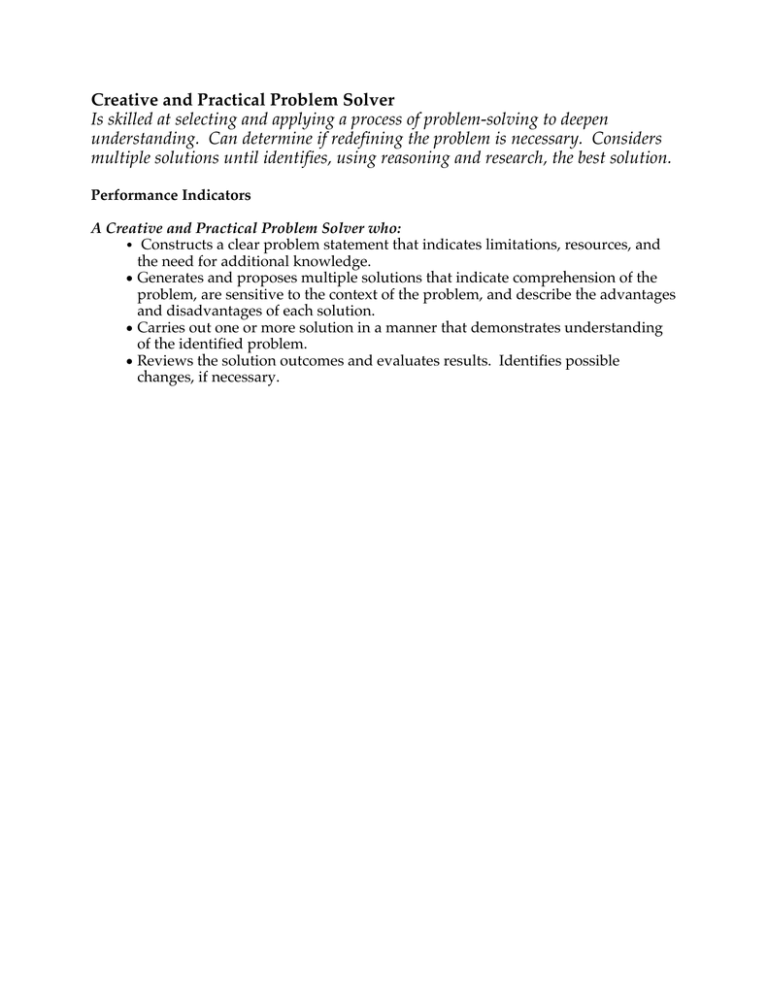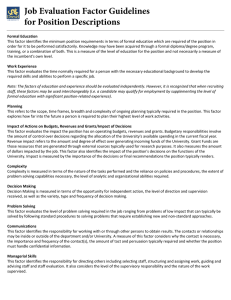Creative and Practical Problem Solver Is skilled at selecting and
advertisement

Creative and Practical Problem Solver Is skilled at selecting and applying a process of problem-solving to deepen understanding. Can determine if redefining the problem is necessary. Considers multiple solutions until identifies, using reasoning and research, the best solution. Performance Indicators A Creative and Practical Problem Solver who: • Constructs a clear problem statement that indicates limitations, resources, and the need for additional knowledge. • Generates and proposes multiple solutions that indicate comprehension of the problem, are sensitive to the context of the problem, and describe the advantages and disadvantages of each solution. • Carries out one or more solution in a manner that demonstrates understanding of the identified problem. • Reviews the solution outcomes and evaluates results. Identifies possible changes, if necessary. Rubric Creative and Practical Problem Solver A. Constructs a clear problem statement that indicates limitations, resources, and the need for additional knowledge. 4. The student’s problem statement is clear, logical, and concise. The consideration of constraints and of research is rich and insightful in relation to the problem. 3. The student’s problem statement is clear and contains no flaws in logic. The consideration of constraints is thorough and relevant to the problem. 2. The student’s problem statement is ambiguous or contains errors in logic indicating a misunderstanding of the problem. Some constraints are considered but their relevance is limited in scope or because of an vague problem statement. 1. The student’s problem statement is unclear or missing. Constraints, resources, or knowledge, if present, are unrelated to the original problem or context. B. Generates and proposes multiple solutions that indicate show the use of research, comprehension of the problem, are sensitive to the context of the problem, and describe the advantages and disadvantages of each solution. (NEED TO INCLUDE RESEARCH IN THIS PROCESS.) 4. The proposal includes multiple solutions that indicate a use of information to sophisticated or deep understanding of the problem. These solutions are evaluated on their merits against the constraints present in the problem. 3. The proposal includes multiple solutions that indicate an understanding of the problem that is thorough and relevant. The solutions are evaluated using research and consider the most important factors and constraints of the problem. 2. The proposal includes multiple solutions that are not evaluated against relevant constraints when choosing which to implement or only one solution is proposed that prevents the evaluation of possible alternatives. Limited research informs solutions. 1. Proposes a solution(s) that is difficult to evaluate because it is vague or fails to adequately address the problem. C. Carries out one or more solution in a manner that demonstrates understanding of the identified problem. 4. The student tests multiple solutions in an organized and deliberate manner, clearly referencing the original problem statement, context and constraints. An outside party would easily connect the implementation to the original problem. 3. The student tests at least one solution in an organized and deliberate manner, making reference to the most important constraints and context for the problem. An outside party would easily connect the implementation to the original problem. 2. The student tests at least one solution but in a disorganized, haphazard manner and/or without referencing the important constraints and context of the problem. As a result an outside party would have difficulty understanding the connection between the implementation and original problem. 1. There is no testing of solutions or the testing is so poorly implemented that any outcomes are unconnected to the original problem, constraints, or context. D. Reviews the solution outcomes and evaluates results. Identifies possible changes, if necessary. 4. The student gives detailed demonstration or description of the process used to review solutions. The student evaluates each solution thoroughly and insightfully in relation to the original problem statement, constraints, and results. The student describes steps taken to make changes to the solution process or if no revision is needed the student makes a clear, concise argument why revisions were unneeded. 3. The student demonstrates or describes the process used to review solutions . The student evaluates solutions in relation to the problem statement and the important constraints and context. If revisions are undertaken, they are clearly described, or if revisions are not needed the student explains why they are unneeded. 2. The review of the solutions suffers from one or more of the following flaws: a vague description of the review undertaken; missing evaluation in relation to the original problem statement, constraints, or context; failure to undertake revisions when called for or, if unneeded, the student fails to explain why. 1. The review is not complete or presented.
